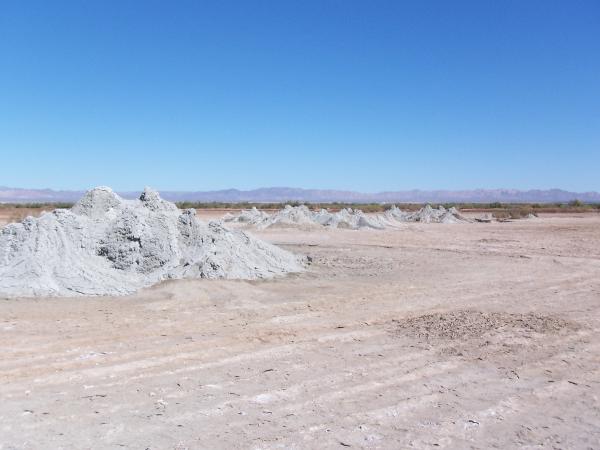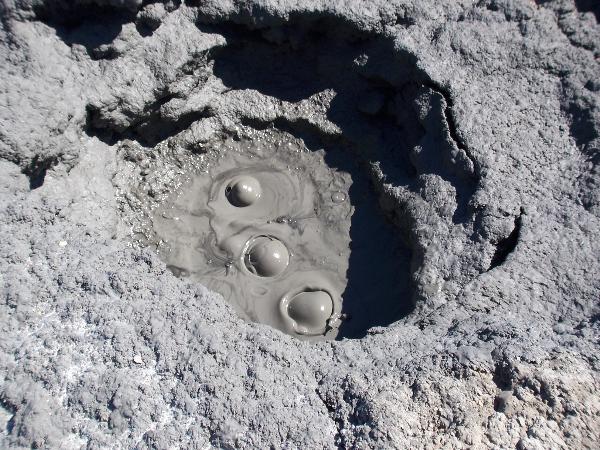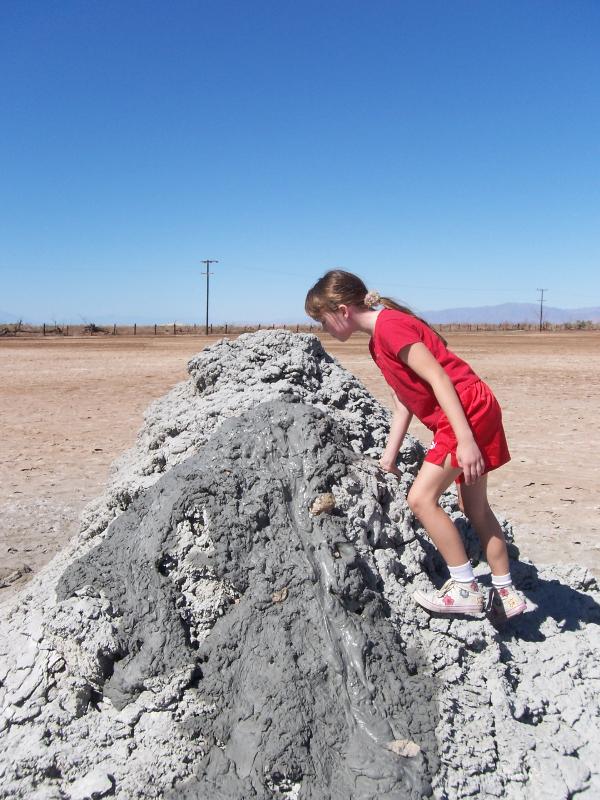
Imperial Valley Mudpots
Posted by:  TerryDad2
TerryDad2
N 33° 12.028 W 115° 34.716
11S E 632485 N 3674411
These mud pots and volcanoes are located in an open field on the eastern side of the Salton Sea. The mud is just above ambient temperature and you can walk right up to the vents.
Waymark Code: WM16EF
Location: California, United States
Date Posted: 01/30/2007
Views: 185
Salton Sea Mud Pots and Volcanoes These mud
pots and volcanoes are located in an open field on the eastern
side of the Salton Sea. The mud is just above ambient
temperature and you can walk right up to the vents.
However this is a natural
system and temperatures will vary Use Caution.
This is also the Imperial Valley Mudpots Earthcache.
 The mud pots and volcanoes are at the corner of
two single-lane, smooth, hard dirt roads, Davis Rd and
Schrimpf Rd. The easiest access is from the north or east. Be
careful about the dirt road you choose as many driveways look
like the main road. The field is covered in mud, so after
rains expect to slog through the slippery stuff. There are no
fences or warning signs at the site, but to be safe
DO NOT ENTER ANY LOW LYING AREA
AS IT MAY BE FILLED WITH CARBON DIOXIDE.
The mud pots and volcanoes are at the corner of
two single-lane, smooth, hard dirt roads, Davis Rd and
Schrimpf Rd. The easiest access is from the north or east. Be
careful about the dirt road you choose as many driveways look
like the main road. The field is covered in mud, so after
rains expect to slog through the slippery stuff. There are no
fences or warning signs at the site, but to be safe
DO NOT ENTER ANY LOW LYING AREA
AS IT MAY BE FILLED WITH CARBON DIOXIDE.
This location has a number of grey cones made of mud up to 6
feet high and some depressions filled with bubbling water and mud.
These features are the result of the geothermal activity in the
area. The entire valley you are in is on the boundary between the
North American Plate to the east and the Pacific Plate to the west.
The geothermal activity is the result of the spreading center
beneath this area. For more info see the Salton Sea Geothermal
Field.
 Even though these features are caused by
geothermal activity beneath the area, the mud and gasses are
usually just above ambient temperature. The bubbles coming out
of the mud are not because they are boiling, but are gasses
escaping up from deep in the earth. These gasses are generated
by the hydrolysis.
Even though these features are caused by
geothermal activity beneath the area, the mud and gasses are
usually just above ambient temperature. The bubbles coming out
of the mud are not because they are boiling, but are gasses
escaping up from deep in the earth. These gasses are generated
by the hydrolysis.
Hydrolysis is the chemical decomposition of a compound into
other compounds by reacting with water. In this case, ground water
is reacting with limestone creating carbon dioxide. This reaction
is likely sped up by the heat of the magma coming from the
spreading center. There is so much carbon dioxide produced in the
area that wells were drilled in the area to extract carbon dioxide
wells and turn it into dry ice before refrigeration was
invented.
 As you approach the mud volcanoes you can often
hear the gurgling and sputtering of gas coming out of the mud.
The level of the water varies by season and between adjacent
pots. While we were there, two of the pots overflowed with mud
and spit globs in the air.
As you approach the mud volcanoes you can often
hear the gurgling and sputtering of gas coming out of the mud.
The level of the water varies by season and between adjacent
pots. While we were there, two of the pots overflowed with mud
and spit globs in the air.
The above information was compiled from the
following sources:
- A Guide to the Unexpected in San Diego and
Beyond, Jerry Schad,
http://www.sdreader.com/php/roamshow.php?id=20010301
- Mud volcano, Wikipedia,
http://en.wikipedia.org/wiki/Mud_volcano
- Imperial Wildlife Area and the Wister Unit — A
year-round display of wonder and wildlife opportunities, Patrick
Moore, originally printed in Outdoor California Magazine, July –
August 2001.,
http://www.dfg.ca.gov/lands/articles/imperial01.html
Resources I would like to have more scientific
resources, but these are what I found. If anyone comes across a
peer reviewed paper on these mud pots please let me know.